steering wheel MERCEDES-BENZ METRIS 2021 MY21 Operator's Manual
[x] Cancel search | Manufacturer: MERCEDES-BENZ, Model Year: 2021, Model line: METRIS, Model: MERCEDES-BENZ METRIS 2021Pages: 290, PDF Size: 4.68 MB
Page 106 of 290
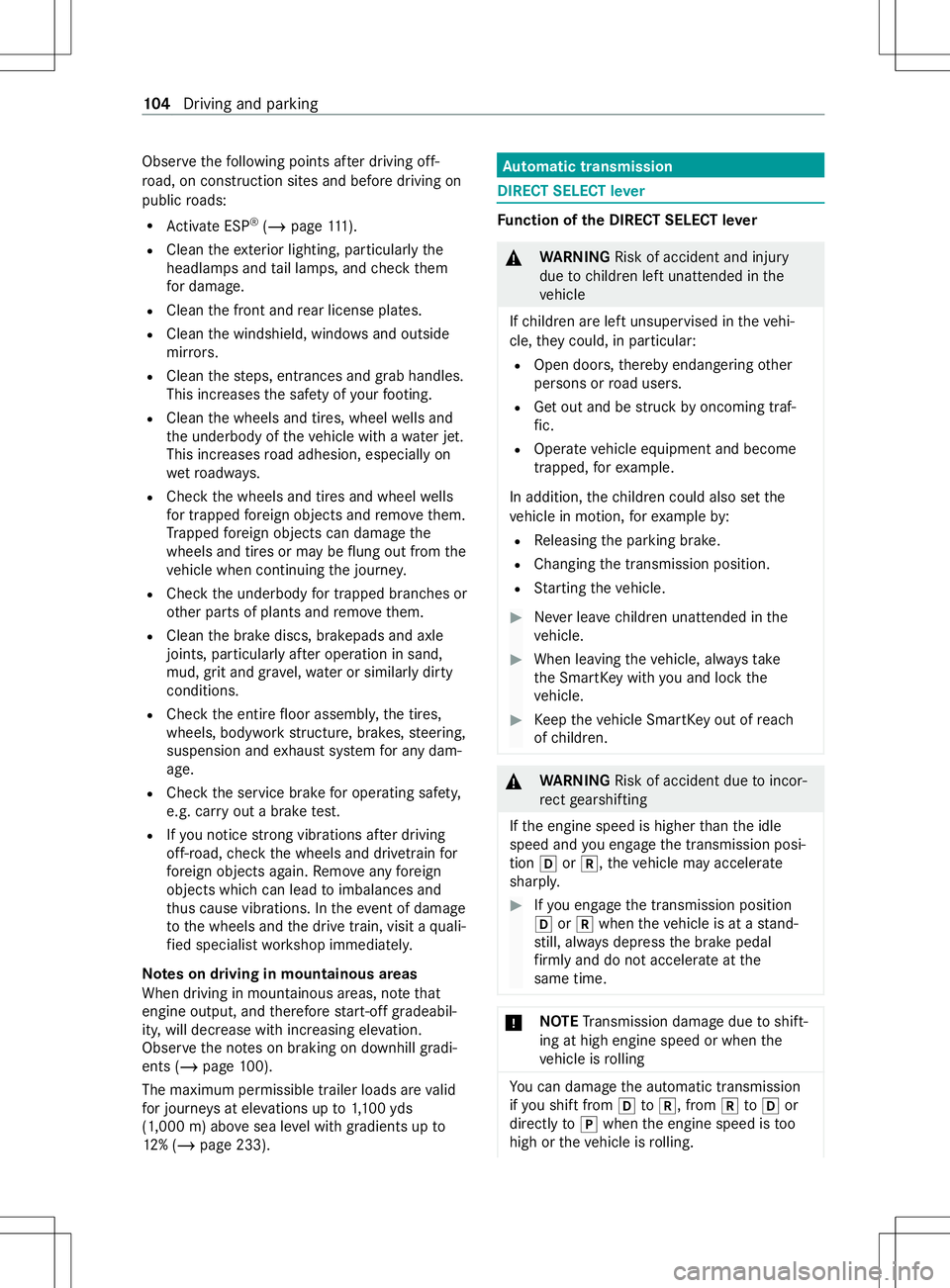
Obser
vethef ollowing points af terd riving off-
ro ad, on con stru ction sites and befor edriving on
publi croads:
R Activat eESP®
(/ page 111 ).
R Clean thee xterio rlighting, particularly the
headlamp sand tail lamps, and checkt hem
fo rd ama ge.
R Clean thef ront and rear licens eplates.
R Clean thew indshield, windo wsand outside
mir rors.
R Clean thes teps, entra nces and grab handles.
Thi sincreases thes afet yofy ourfoot ing.
R Clean thew heels and tires, wheel wells and
th eu nderbody of thev ehicle wit hawater jet.
Thi sincrease sroad adhesion ,especiall yon
we troadw ays.
R Chec kthe wheels and tires and wheel wells
fo rt rapped fore ign object sand remo vethem.
Tr apped fore ign object scan damag ethe
wheels and tires or ma ybeflung out from the
ve hicle when continuing thej ourne y.
R Chec kthe underbody fort rapped branches or
ot her parts of plants and remo vethem.
R Clean theb rake discs, brakepads and axle
joints, particularly af tero peration in sand,
mud, grit and gr avel,wate rors imilarly dirty
conditions.
R Chec kthe entir efloor assembly ,the tires,
wheels, bodywor kstructure, brakes, steering,
suspension and exhaus tsystemf or an ydam‐
age.
R Chec kthe service brak efor operating saf ety,
e.g. car ryout abrake test.
R Ifyo un otices tron gv ibra tions af terd riving
off-road, checkt he wheels and driv etra in for
fo re ign object sagain. Remo veanyforeign
object swhichc an lead toimbalances and
th us caus evibrations .Intheeve nt of damage
to thew heels and thed rive train, visit aquali‐
fi ed specialis tworks hop immediately.
Note sond riving in mountainous areas
When driving in mountainous areas, no tethat
engine output, and therefor estart-o ff gradeabil‐
ity ,w ill dec rease wit hincreasin geleva tion.
Obser vethen otes on braking on downhill gradi‐
ents (/ page100).
The maximu mpermissible trailer loads ar evalid
fo rj ourne ysat ele vations up to1,10 0y ds
(1,000 m) abo vesea le velw ithg radient supto
12 %( / pag e233). Au
tomatic transmission DIREC
TSELECT lever Fu
nction of theD IRECT SELECT le ver &
WARNING Risk of accident and injury
du etoc hildren lef tunat tende dint he
ve hicle
If ch ildren ar eleftu nsupervised in thev ehi‐
cle, they could, in pa rticular:
R Open doors, thereb yendangering other
persons or road users.
R Getout and be stru ck byoncomin gtraf‐
fi c.
R Ope rate ve hicle equipment and become
trapped, fore xamp le.
In addition ,the children could also se tthe
ve hicle in motion, fore xamp leby:
R Releasing thep arking brake.
R Changing thet ransmission position.
R Startin gthe vehicle. #
Neverlea ve children unat tende dint he
ve hicle. #
When leaving thev ehicle, alw ayst ake
th eS martK eywit hyou and loc kthe
ve hicle. #
Keep thev ehicle SmartK eyout of reach
of children. &
WARNING Risk of accident du etoincor‐
re ct gearshifting
If th ee ngine speed is higher than thei dle
speed and youe ngag ethe transmission posi‐
tion 005Bor005E,t hevehicle ma yaccelerate
sharply. #
Ifyo ue ngag ethe transmission position
005B or005E when thev ehicle is at astand‐
st ill, alw aysd epress theb rake pedal
fi rm lyand do no taccelerat eatthe
same time. *
NO
TETransmission damag eduetoshift‐
ing at high engine speed or when the
ve hicle is rolling Yo
uc an damag ethe automatic transmission
if yo us hiftfrom 005Bto005E ,from 005Eto005B or
directl yto005Dwhen thee ngine speed is too
high or thev ehicle is rolling. 104
Driving and pa rking
Page 108 of 290
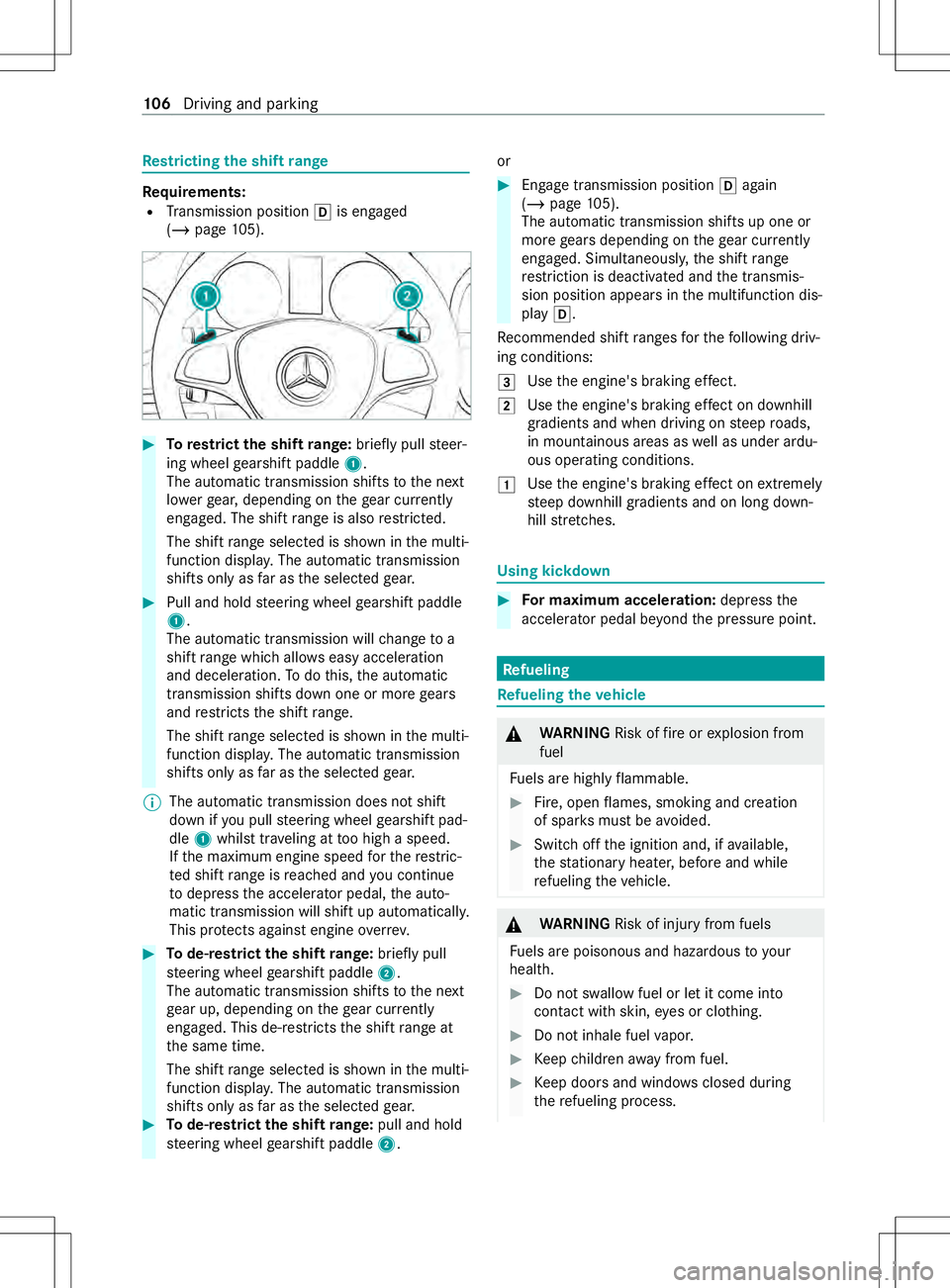
Re
strictin gthe shi ftrange Re
quirements:
R Transmission position 005Bis engaged
(/ page105). #
Torestrict th eshiftrange: briefly pull steer‐
ing wheel gearshif tpaddle 1.
The automatic transmissio nshifts tothen ext
lo we rgear ,dependin gonthegear cur rently
engaged .The shi ftrang eisa lsor estricted.
The shif trang eselected is shown in them ulti‐
function displa y.The automatic transmission
shifts onl yasfar as thes elected gear. #
Pull and hold steering wheel gearshif tpaddle
1.
The automatic transmissio nwillch ang etoa
shif trang ewhich allo wseasy acceleration
and deceleration. Todo this, thea utomatic
transmission shifts down one or mor egears
and restricts thes hiftrange.
Th es hift rang es elected is shown in them ulti‐
function displa y.The automatic transmission
shifts onl yasfar as thes elected gear.
% The automatic transmissio
ndoes no tshift
down if youp ullsteering wheel gearshif tpad‐
dle 1whils ttrave ling at tooh igh aspeed.
If th em aximum engine speed fort he restric‐
te ds hiftrang eisr eached and youc ontinue
to depress thea ccelera torp edal, thea uto‐
matic transmission will shif tupautomaticall y.
This pr otects agains tengine overrev. #
Tode-restric tthe shi ftrange: briefly pull
st eering wheel gearshif tpaddle 2.
The automatic transmissio nshifts tothen ext
ge ar up, dependin gonthegear cur rently
engaged .Thisd e-re stricts thes hiftrang eat
th es ame time.
The shif trang eselected is shown in them ulti‐
function displa y.The automatic transmission
shifts onl yasfar as thes elected gear. #
Tode-restric tthe shi ftrange: pull and hold
st eering wheel gearshif tpaddle 2. or #
Engage transmission position 005Bagain
(/ page 105).
The auto matic transmission shifts up one or
mor egear sdepending on theg ear cur rently
engaged .Simultaneously ,the shif trange
re striction is deactivated and thet ransmis‐
sion position appear sinthe multifunction dis‐
play 005B.
Re commended shi ftranges fort he following driv‐
ing conditions:
0049 Use
thee ngine' sbraking ef fect.
0048 Use
thee ngine' sbraking ef fect on downhill
gradients and whe ndriving on steep roads,
in mountainous areas as well as under ardu‐
ous operatin gconditions.
0047 Use
thee ngine' sbraking ef fect on extreme ly
st eep downhill gradients and on long down‐
hill stre tches. Usin
gkickdown #
Form aximum acceleration: depressthe
accelerator pedal be yond thep ressur epoint. Re
fueling Re
fueling thev ehicle &
WARNING Risk offire or explosion from
fuel
Fu els ar ehighly flammable. #
Fire, open flames ,smokin gand creation
of spar ksmus tbea voided. #
Swit chofft he ignition and, if available,
th es tationar yheater ,befor eand while
re fueling thev ehicle. &
WARNING Risk of inju ryfrom fuels
Fu els ar epoisonous and hazardous to your
health. #
Do no tswa llowf uel or le titcomeinto
con tact wi thskin, eyes or clo thing. #
Do no tinhale fuel vapor. #
Keep children away from fuel. #
Keep door sand windo wsclosed du ring
th er efueling process. 106
Driving and pa rking
Page 113 of 290
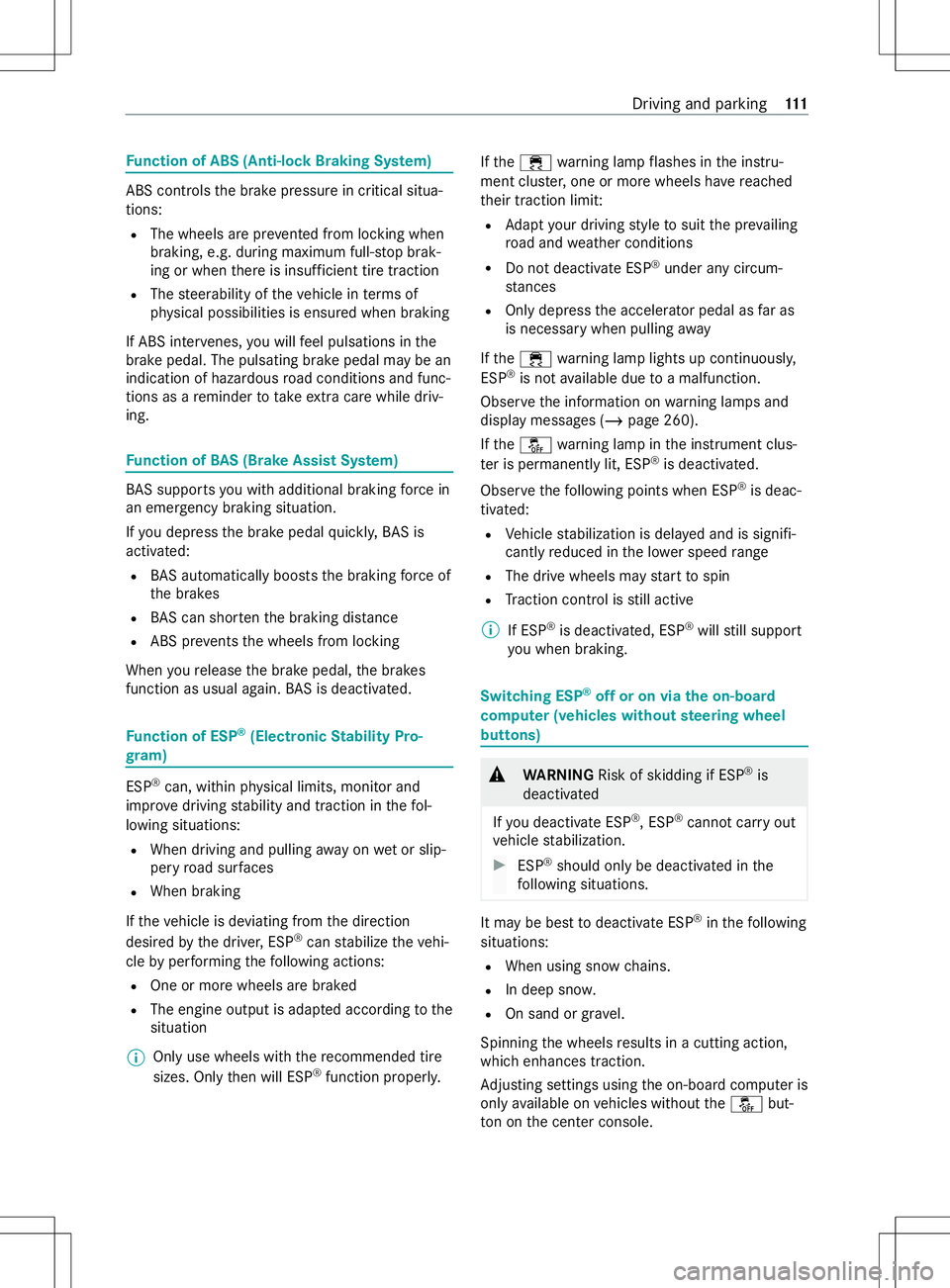
Fu
nction of ABS (Anti-loc kBraking Sy stem) AB
Sc ontrols theb rake pressur eincritical situa‐
tions:
R The wheels ar epreve nted from lo cking when
braking, e.g. during maximum full-s topb rak‐
ing or when ther eisi nsufficient tir etraction
R The steerability of thev ehicle in term sof
ph ysical possibilities is ensured when braking
If AB Sinter venes, youw illfeel pulsations in the
brak epedal. The pulsating brak epedal ma ybean
indication of hazardous road condition sand func‐
tions as areminder totake extrac arew hile driv‐
ing. Fu
nction of BAS(Brak eAssis tSystem) BA
Ss uppo rtsy ou wit hadditional braking forc ein
an emer gency braking situation.
If yo ud epress theb rake pedal quickl y,BA Sis
acti vated:
R BASa utom atical lyboosts theb raking forc eof
th eb rakes
R BASc an sho rten theb raking dis tance
R ABS pr events thew heels from locking
When your elease theb rake pedal, theb rakes
function as usual again. BASisd eactivated. Fu
nction of ESP ®
(Electronic Stability Pro‐
gr am) ESP
®
can, within ph ysical limits, monitor and
impr oved riving stabilit yand traction in thef ol‐
lowing situations:
R When driving and pullinga wayonw etor slip‐
pe ry road sur faces
R Whe nbraking
If th ev ehicle is deviating from thed irection
desired bythed rive r,ESP ®
can stabiliz ethe vehi‐
cle byper form ing thef ollowing actions:
R One or mor ewheels ar ebraked
R The engin eoutput is adap teda ccording tothe
situation
% Only use wheels wit
hthe recommended tire
sizes. Only then will ESP ®
function properly. If
the 00E5 warning lam pflashes in thei nstru‐
ment clus ter,one or mor ewheels ha vereached
th eir traction limit:
R Adapty our driving styletos uitthep reva iling
ro ad and weather conditions
R Do no tdeactivat eESP®
unde rany circum‐
st ances
R Only depress thea ccelerator pedal as faras
is necessar ywhen pulling away
If the 00E5 warning lam plight supc ontinuousl y,
ESP ®
is no tavailable due toam alfunction.
Obse rvet he information on warning lamps and
displa ymessages (/ page260).
If the 00BB warning lam pinthe instrument clus‐
te risp ermanently lit, ESP ®
is deactivated.
Obser vethef ollowing points when ESP ®
is deac‐
tivated:
R Vehicle stabilizatio nisdelayeda nd is signifi‐
cantly reduced in thel owe rspeed range
R The driv ewheelsm aystar ttos pin
R Traction control is still active
% If ESP ®
is deactivated, ESP ®
will still support
yo uw hen braking. Swit
ching ESP ®
of foronv iatheo n-boa rd
compu ter( ve hicles withou tsteering wheel
but tons) &
WARNING Risk of skidding if ESP ®
is
deactivated
If yo ud eactivat eESP®
,E SP ®
canno tcarry out
ve hicle stabilization. #
ESP ®
should onl ybedeactivated in the
fo llowing situations. It ma
ybeb esttod eactivat eESP®
in thef ollowing
situations:
R When using sno wchains.
R In deep sno w.
R On sand or gr avel.
Spinnin gthe wheels results in acutting action,
whic henhances traction.
Ad justing setting susing theo n-boar dcomputer is
onl yavailable on vehicles without the00BB but‐
to nont he center console. Driving and parking
111
Page 114 of 290
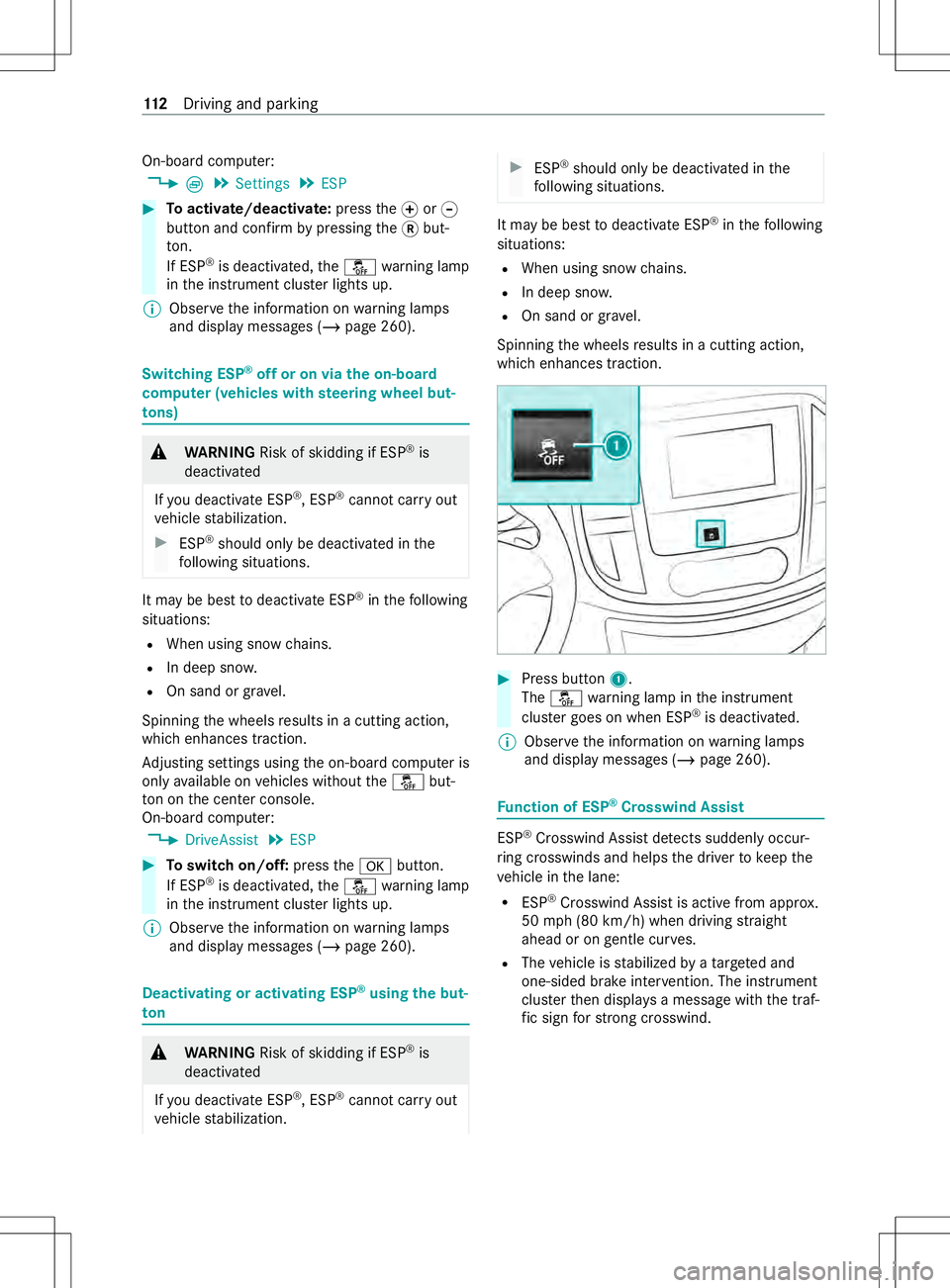
On-boar
dcomputer:
4 È5
Settings 5
ESP #
Toactivate/deactivate: pressthe0074or0075
button and confir mbypressing the0078but‐
to n.
If ESP ®
is deacti vated, the 00BB warning lamp
in thei nstrument clus terl ights up.
% Obser
vethei nformation on warning lamps
and displa ymessages (/ page260). Switching ESP
®
of foronv iatheo n-boa rd
compu ter( ve hicles with steering wheel but‐
to ns) &
WARNING Risk of skidding if ESP ®
is
deactivated
If yo ud eactivat eESP®
,E SP ®
canno tcarry out
ve hicle stabilization. #
ESP ®
shoul donlybed eactivated in the
fo llowing situations. It ma
ybeb esttod eactivat eESP®
in thef ollowing
situations:
R When using sno wchains.
R In deep sno w.
R On sand or gr avel.
Spinnin gthe wheels results in acutting action,
whic henhances traction.
Ad justing setting susing theo n-boar dcomputer is
onl yavailable on vehicles without the00BB but‐
to nont he center console.
On-boar dcomputer:
4 DriveAssist 5
ESP #
Toswitc hon/off: pressthe0076 button.
If ESP ®
is deactivated, the00BB warning lamp
in thei nstrument clus terl ights up.
% Obser
vethei nformation on warning lamps
and displa ymessages (/ page260). Deactivating or activating ESP
®
using theb ut‐
ton &
WARNING Risk of skidding if ESP ®
is
deactivated
If yo ud eactivat eESP®
,E SP ®
canno tcarry out
ve hicle stabilization. #
ESP ®
should onl ybedeactivated in the
fo llowing situations. It ma
ybeb esttod eactivat eESP®
in thef ollowing
situations:
R When using sno wchains.
R In deep sno w.
R On sand or gr avel.
Spinnin gthe wheels results in acutting action,
whic henhances traction. #
Press button 1.
The 00BB warning lam pinthe instrument
clus terg oes on when ESP ®
is deactivated.
% Obser
vethei nformation on warning lamps
and displa ymessages (/ page260). Fu
nction of ESP ®
Crosswind Assist ESP
®
Crosswind Assis tdetects suddenly occur‐
ri ng crosswinds and helps thed rive rtok eepthe
ve hicle in thel ane:
R ESP ®
Crosswind Assis tisactivefroma pprox.
50 mph(80 km/h) when driving stra ight
ahead or on gentle cur ves.
R The vehicle is stabilized byatarge teda nd
one-sided brak einter vention. The instrument
clu ster then displa ysam essag ewitht he traf‐
fi cs ignf or stro ng crosswind. 11 2
Driving and pa rking
Page 122 of 290
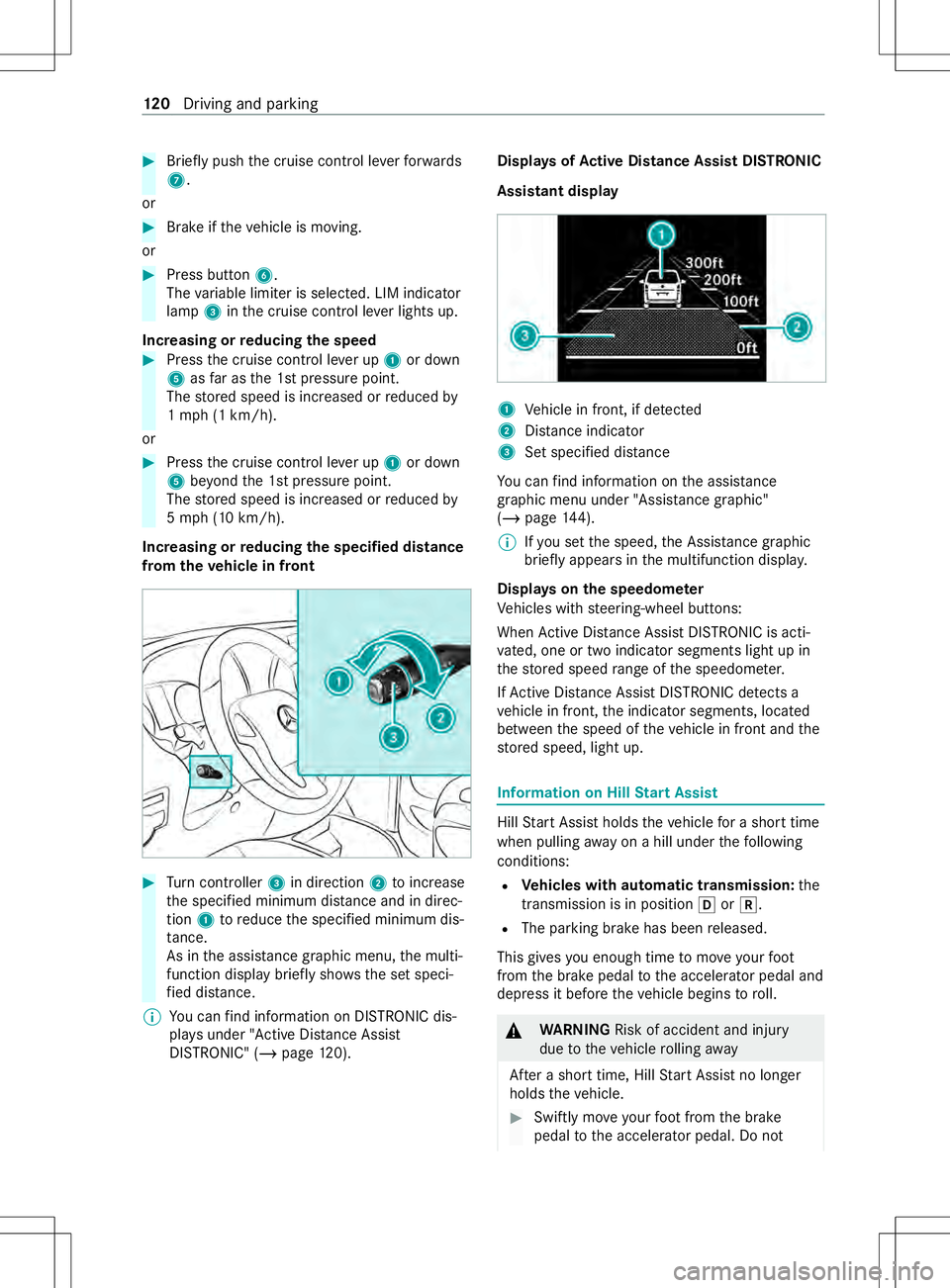
#
Brief lypush thec ruise cont rolleve rfor wa rds
7 .
or #
Brak eifthevehicle is moving.
or #
Press button 6.
The variable limiter is selec ted. LIM indicator
lamp 3inthec ruise cont rollev er lights up.
Increasin gorreducing th espeed #
Press thec ruise cont rolleve rup1or down
5 asfarast he 1s tpressur epoint.
The stored speed is increased or reduced by
1m ph (1 km/h).
or #
Press thec ruise cont rolleve rup1or down
5 beyond the1 stpressur epoint.
The stored speed is increased or reduced by
5m ph (1 0km/h).
Increasing or reducing the specifie ddistance
from the vehicl einf ront #
Turn controller 3in direction 2toinc rease
th es pecified minimum dis tance and in di rec‐
tion 1toreduce thes pecified minimum dis‐
ta nce.
As in thea ssis tance graphi cmenu ,the multi‐
function displa ybrief ly sho ws th esetspeci‐
fi ed dis tance.
% Yo
uc an find information on DISTRONIC dis‐
pl ay su nder "Activ eDista nce Assi st
DISTRONIC" (/ page 120). Displa
ysofActiv eD ista nce Assis tDISTRONIC
Assi stant display 1
Vehicle in front, if de tected
2 Distance indica tor
3 Setspecifie ddista nce
Yo uc an find information on thea ssis tance
graphi cmenu under "Assis tance graphic"
(/ page 144).
% If
yo us etthes peed, theA ssis tance graphic
brie flya ppear sinthe multifunction displa y.
Displa yson thes peedome ter
Ve hicles wit hsteering-wheel buttons:
When ActiveD ista nce Assi stDISTRONI Cisacti‐
va ted, one or tw oindicator segments light up in
th es tore ds peed rang eoft he speedome ter.
If Ac tiveD ista nce Assi stDISTRONI Cdetects a
ve hicle in front, thei ndicator segments, located
between thes peed of thev ehicle in front and the
st ored speed, light up. Information on Hill
StartA ssist Hill
StartA ssisth olds thev ehicle foras horttime
when pulling away on ahill under thef ollowing
conditions:
R Vehicles with automatic transmission: the
transmission is in position 005Bor005E.
R The pa rking brak ehas been released.
This gives youe nough tim etomoveyour foot
from theb rake pedal tothea ccelerator pedal and
depress it befor ethe vehicle begins toroll. &
WARNING Risk of accident and injury
du etot hevehicle rolling away
Af teras horttime, Hill StartA ssistnol onger
holds thev ehicle. #
Swiftl ymove your foot from theb rake
pedal tothea ccelera torp edal. Do not 12 0
Driving and pa rking
Page 127 of 290
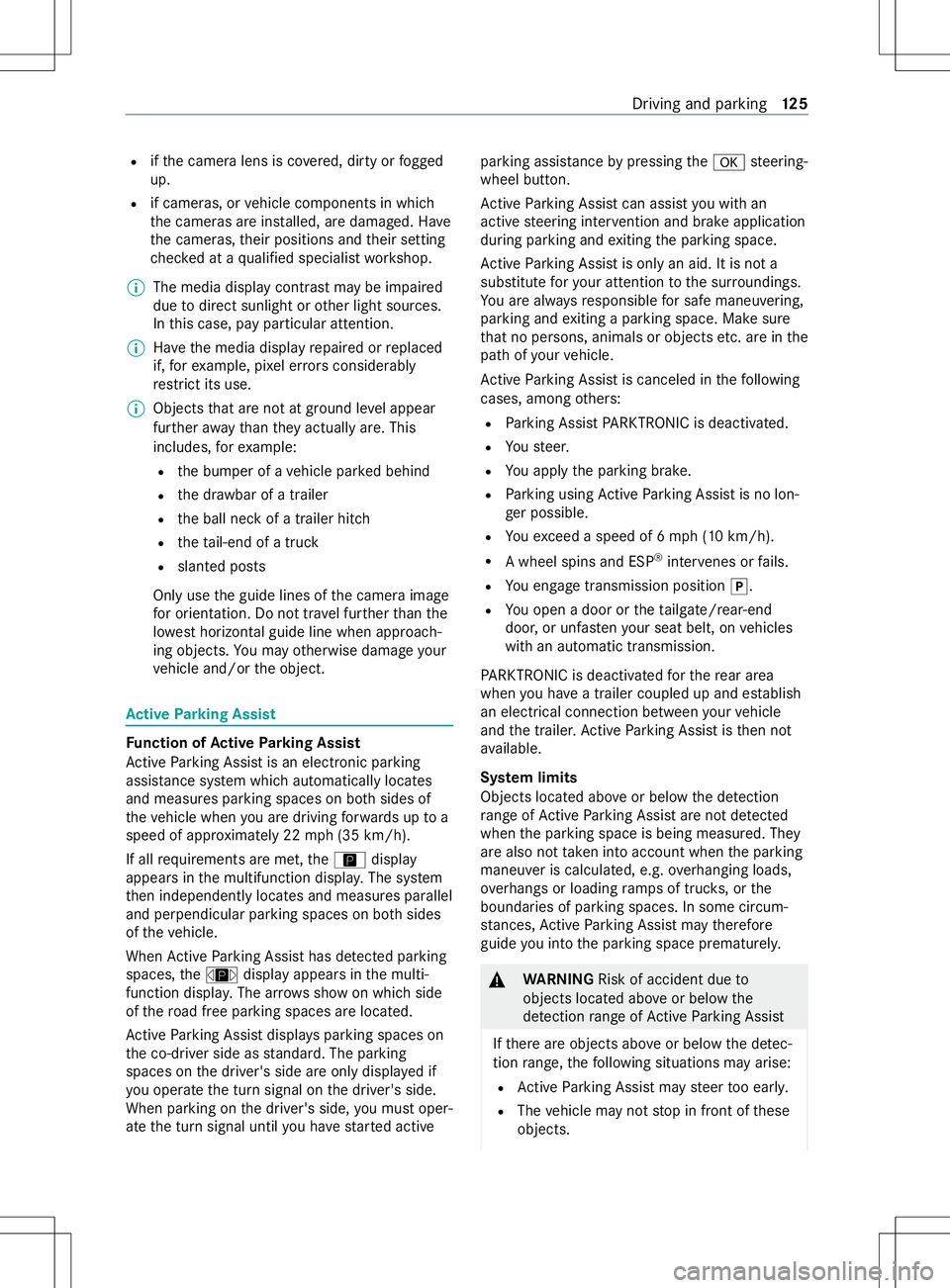
R
ifth ec amera lens is co vered, dirty or fogged
up.
R if cameras, or vehicle components in which
th ec amera sareins talled, ar edamaged. Ha ve
th ec ameras, their position sand their setting
ch eckedataq ualified specialis tworks hop.
% The media displa
ycontra stma ybei mpaired
due todirect sunlight or other light sources.
In this case, pa yparticular attention.
% Ha
ve them edia displa yrepaired or replaced
if, fore xamp le, pixel er rors considerably
re strict its use.
% Objects that ar enotat ground le vela ppear
fur ther aw ay than they actuall yare.T his
includes, fore xamp le:
R theb umper of avehicle par kedb ehind
R thed rawbar of atrailer
R theb all nec kofat railer hitch
R thet ail-en dofat ruck
R slanted posts
Onl yusetheg uide lines of thec amer aimage
fo ro rientation. Do no ttrave lfur ther than the
lo west horizontal guide line when approach‐
ing objects. Youm ayotherwise damag eyour
ve hicle and/or theo bject. Ac
tiv eP arking Assist Fu
nction of Activ eP arking Assist
Ac tiveP arking Assis tisanelectronic pa rking
assis tance sy stem whic hautomaticall ylocates
and measures parking spaces on bo thsides of
th ev ehicle when youa redrivin gforwa rdsuptoa
speed of appr oximately 22 mph(35 km/h).
If al lrequirements ar emet,t he Ç display
appear sinthe multifunction displa y.The sy stem
th en independentl ylocates and measures parallel
and perpendicular parking spaces on bo thsides
of thev ehicle.
When ActiveP arking Assis thas de tected pa rking
spaces ,the È displa yappear sinthe multi‐
function displa y.The ar rowsshowonw hichs ide
of ther oad free parking spaces ar elocated.
Ac tiveP arking Assis tdispla ysparking spaces on
th ec o-driver side as standard. The parking
spaces on thed rive r's side ar eonlyd ispla yedif
yo uo perat ethe tur nsignal on thed rive r's side.
When parking on thed rive r's side, youm usto per‐
at et he tur nsignal until youh aves tarted active parking assis
tancebypressing the0076 steering-
wheel button.
Ac tiveP arking Assis tcan assis tyou wit han
activ esteering inter vention and brak eappli cation
du ring pa rking and exitin gthe parking space.
Ac tiveP arking Assis tisonlyana id. It is no ta
substitut efor your attention tothes urroundings.
Yo ua realw aysr esponsibl efor saf emaneu vering,
pa rking and exitin gap arkin gspace. Mak esure
th at no persons, animals or object setc. ar einthe
pat hofy ourvehicle.
Ac tiveP arking Assis tiscanceled in thef ollowing
cases, among others:
R Parking Assis tPARKTRONIC is deactivated.
R Yous teer.
R Youa ppl ythe parking brake.
R Parking using ActiveP arking Assis tisnolon‐
ge rp ossible.
R Youe xceed aspeed of 6mph (1 0km/h).
R Awheel spins and ESP ®
inter venes or fails.
R Youe ngag etransmission position 005D.
R Youo pen adoor or thet ailgate/rear-end
door ,oru nfasteny our seat belt, on vehicles
wit hana utomatic transmission.
PA RKTRONI Cisdeactivated fort he rear area
when youh aveat railer coupled up and es tablish
an electrical connection between your vehicle
and thet railer .Activ eParking Assis tisthen not
av ailable.
Sy stem limits
Object slocated abo veor belo wthe de tection
ra ng eofA ctiveParking Assis tare notd etected
when thep arking space is being measured. They
ar ea lso no ttaken in toaccount when thep arking
maneuver is calculated, e.g. overhanging loads,
ove rhangs or loadin gramps of truc ks,ort he
boundaries of parking spaces. In some circum‐
st ances, ActiveP arking Assis tmaytherefore
guide youi ntot he parking space prematurely. &
WARNING Risk of accident du eto
object slocated abo veor belo wthe
de tection rang eofA ctiveParking Assist
If th er ea reobject sabove or belo wthe de tec‐
tion range, thef ollowing situations ma yarise:
R ActiveP arking Assis tmaysteer tooe arly.
R The vehicle ma ynotstop in front of these
objects. Driving and parking
12 5
Page 128 of 290
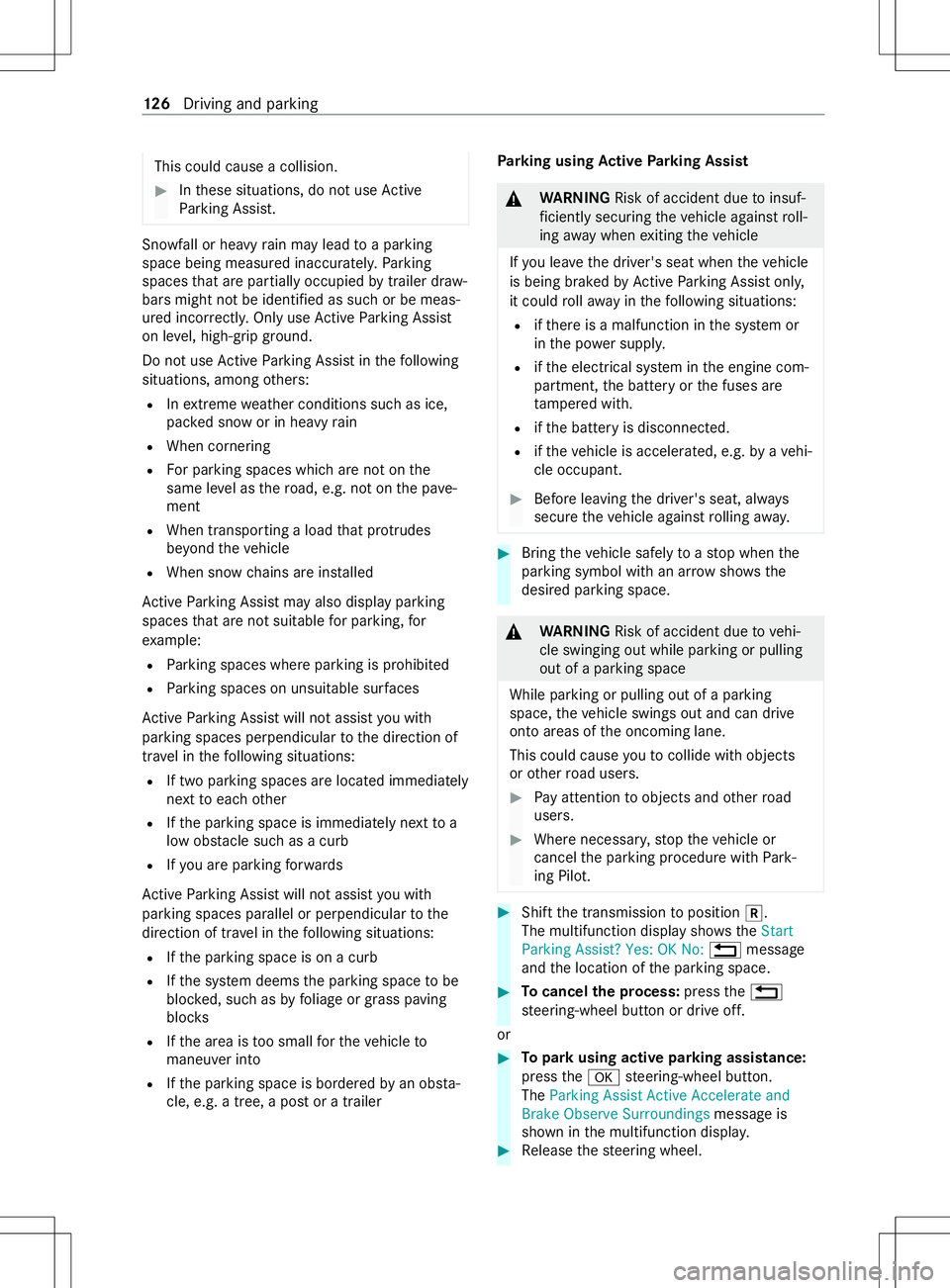
This could cause
acollision. #
Inthese situations, do no tuse Active
Pa rking Assist. Sn
owfa ll or heavy rain ma ylead toap arking
spac ebeingm easured inaccuratel y.Pa rking
spaces that ar epartiall yoccupied bytraile rdraw‐
bar sm ight no tbeidentified as suc horbemeas‐
ured incor rectly .Only use ActiveP arking Assist
on le vel, high-grip ground.
Do no tuse ActiveP arking Assis tinthefollowing
situations ,amon gothers:
R Inextreme weather condition ssuchasi ce,
pac keds noworinh eavyrain
R When cornering
R Forp arking space swhicha renotont he
same le velast heroad, e.g .not on thep ave‐
ment
R When transporting aloa dt hat pr otru des
be yond thev ehicle
R When sno wchains ar einstalled
Ac tiveP arking Assis tmayalso displa yparking
spaces that ar enotsuitable forp arking, for
ex ample:
R Parking spaces wher eparkin gisp rohibited
R Parking spaces on unsuitable sur faces
Ac tiveP arking Assis twill no tassis tyou with
parking spaces perpendicular tothed irection of
tra velint hefollowing situations:
R If tw oparkin gspaces ar elocated immediately
next toeac hother
R Ifth ep arking space is immediatel ynexttoa
lo wo bstacle suc hasac urb
R Ifyo ua reparkin gforwa rds
Ac tiveP arking Assis twill no tassis tyou with
parking spaces parallelorp erpendiculartothe
direction of tra velint hefollowing situations:
R Ifth ep arking space is on acurb
R Ifth es ystemd eems thep arking space tobe
bloc ked, suc hasbyf oliageorg rass paving
bloc ks
R Ifth ea reaist oo small fort he vehicle to
maneuver into
R Ifth ep arking space is bordered byan obs ta‐
cle, e.g. atree, ap ostora trailer Park
ing using Activ eP arkin gAssist &
WARNING Risk of accident du etoinsuf‐
fi ciently secu ring thev ehicle agains troll‐
ing away when exitin gthe vehicle
If yo ul eave thed rive r's seat when thev ehicle
is being braked byActiveP arking Assis tonly,
it could rollaw ay inthef ollowing situations:
R ifth er eisam alfunction in thes ystemor
in thep owe rsupply.
R ifth ee lectrical sy stem in thee ngine com‐
partment, theb atter yort he fuses are
ta mp ered with.
R ifth eb atter yisd isconnected.
R ifth ev ehicle is accelerated, e.g. byavehi‐
cle occupant. #
Befor eleaving thed rive r's seat, alw ays
secur ethe vehicle agains trolling away. #
Bring thev ehicle safel ytoastopw hen the
parking symbol wit hanarrow sho ws the
desired parking space. &
WARNING Risk of accident du etovehi‐
cle swinging out while parking or pulling
out of aparking space
While parking or pulling out of aparking
space, thev ehicle swings out and can drive
ont oareas of theo ncoming lane.
This could cause youtoc ollide wi thobjects
or other road users. #
Paya ttention toobject sand other road
users. #
Wher enecessar y,stop thev ehicle or
cancel thep arking procedur ewithP ark‐
ing Pilot. #
Shif tthe transmission toposition 005E.
The multifunction displa yshows the Start
Parking Assist ?Yes: OK No: ~message
and thel ocation of thep arking space. #
Tocancel thep rocess: pressthe~
st eering-wheel button or driv eoff.
or #
Topar kusing acti veparkin gassistance:
press the0076 steering-wheel button.
The Parking Assist Active Accelerate and
Brake Observe Surroundings messageis
shown in them ultifunction displa y. #
Release thes teering wheel. 12 6
Driving and pa rking
Page 130 of 290
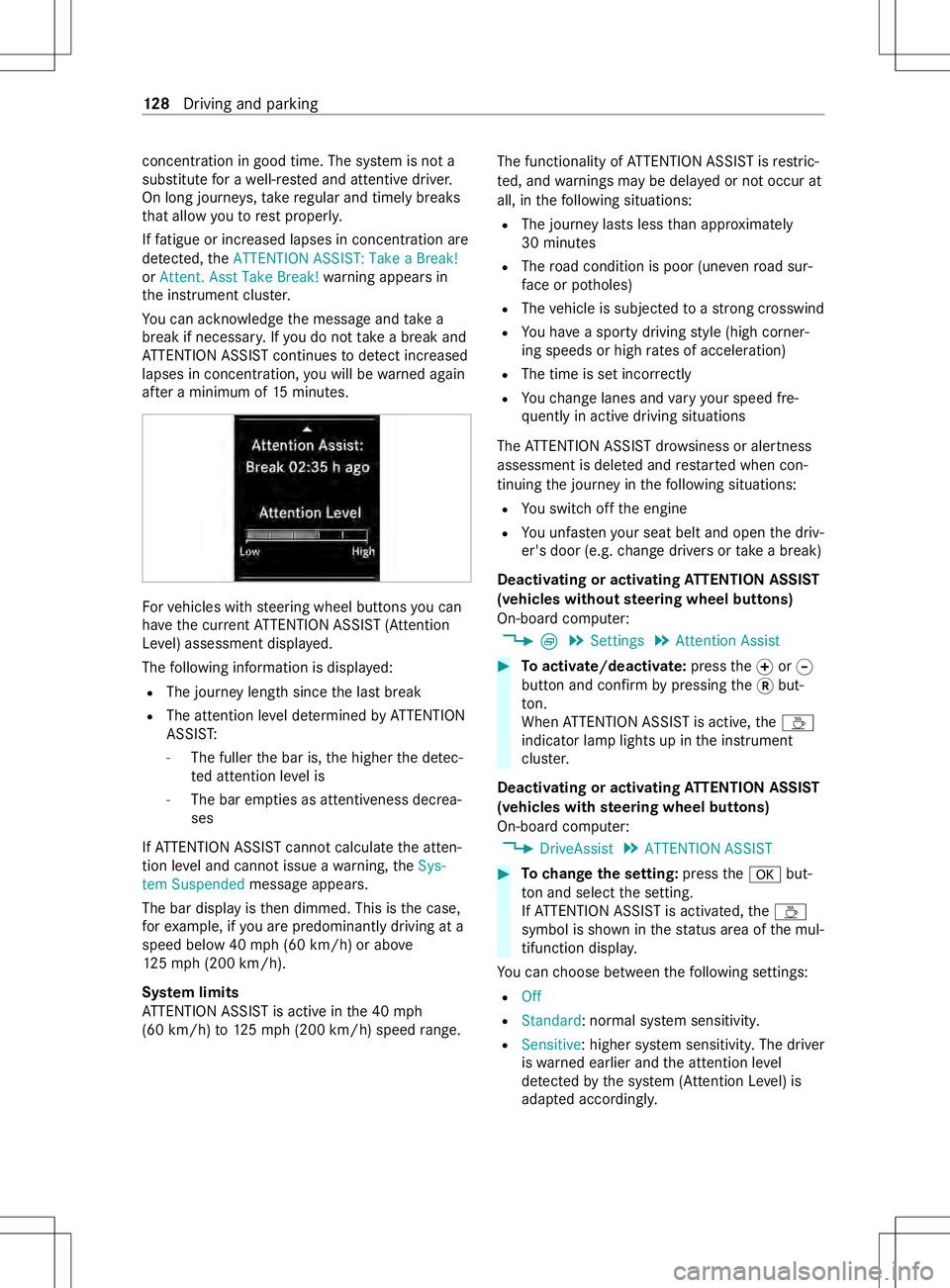
concentration in goo
dtime. The sy stem is no ta
substitut efor aw ell-res teda nd attentiv edrive r.
On long journe ys,tak er egular and timel ybreaks
th at allo wyoutorest properly.
If fatigue or increased lapse sinconcentration are
de tected, theATTENTION ASSIST: Take aBreak!
or Attent. Asst Take Break! warning appear sin
th ei nstrument clus ter.
Yo uc an ackn owledg ethe messag eand take a
break if necessar y.Ifyo udon ottake ab reak and
AT TENTION ASSIS Tcontinues todetect increased
lapse sinconcentration, youw ill be warned again
af te ram inimu mof15m inutes. Fo
rv ehicles wit hsteering wheel buttons youc an
ha ve thec urrent ATTENTION ASSIS T(Attention
Le vel) assessment displa yed.
The following informatio nisdisplayed:
R The journe ylengt hsincethe las tbreak
R The attention le veld etermined byATTENTION
ASSIS T:
- The fuller theb ar is, theh igher thed etec‐
te da ttention le velis
- The bar em pties as attentivenes sdecrea‐
ses
If AT TENTION ASSIS Tcann otcalculat ethe atten‐
tion le vela nd canno tissue awarning ,the Sys-
tem Suspended messageappears.
The bar displa yisthen dimmed. This is thec ase,
fo re xamp le, ifyoua repredominantl ydrivin gata
spee dbelow40m ph (60 km/h) or abo ve
12 5m ph (200 km/h).
Sy stem limits
AT TENTION ASSIS Tisactiveint he 40 mph
(60 km/h) to125m ph (200 km/h) speed range. The functionality of
ATTENTION ASSIS Tisrestric‐
te d, and warnings ma ybedelayedorn otoccur at
all, in thef ollowing situations:
R The journe ylasts less than appr oximately
30 minutes
R The road condition is poor (une venr oad sur‐
fa ce or po tholes)
R The vehicle is subjected toas tron gc rosswind
R Youh ave asporty drivin gstyle (hig hcorner‐
ing speeds or high ratesofa cceleration)
R The time is se tincor rectly
R Youc hang elane sand vary your spee dfre‐
qu ently in activ edriving situations
The ATTENTION ASSIS Tdrow sines sora lertness
assessment is dele teda nd restar tedw hen con‐
tinuin gthe journe yinthefollowing situations:
R Yous wit ch offt he engine
R Youu nfas teny our seat belt and open thed riv‐
er's door (e.g. chang edrive rs or tak eabreak)
Deactivating or activating ATTENTION ASSI ST
(vehicles without steering wheel but tons)
On-boar dcomputer:
4 È5
Settings 5
Attention Assist #
Toactivate/deactivate: pressthe0074or0075
button and confir mbypressing the0078but‐
to n.
Whe nATTENTION ASSIS Tisactive, the00AD
indicator lam plights up in thei nstrument
clus ter.
Deactivating or activating ATTENTION ASSI ST
(vehicles wit hsteering wheel but tons)
On-boar dcomputer:
4 DriveAssist 5
ATTENTION ASSIST #
Tochang ethe setting: pressthe0076 but‐
to na nd select thes etting.
If AT TENTION ASSIS Tisactivated, the00AD
symbol is shown in thes tatus area of them ul‐
tifunction displa y.
Yo uc an choose between thef ollowing settings:
R Off
R Standard:n ormal system sensitivity.
R Sensitive:h igher system sensitivity .The driver
is wa rned earlier and thea ttention le vel
de tected bythes ystem( Attention Le vel) is
adap teda ccording ly. 12 8
Driving and pa rking
Page 138 of 290
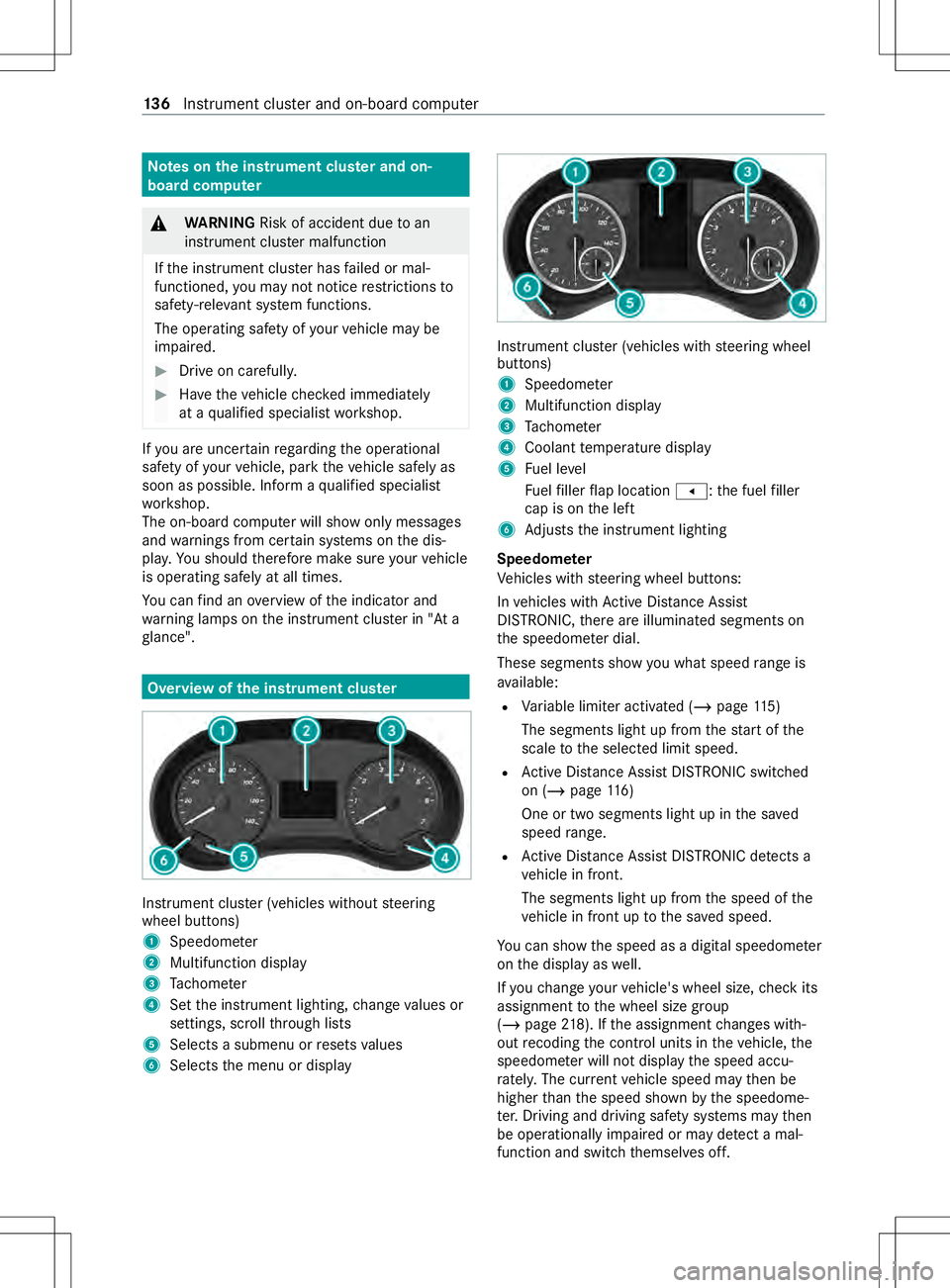
Note
sont he instrument clu ster an don-
board co mputer &
WARNING Risk of accident du etoan
instrumen tclus term alfunction
If th ei nstrument clus terh as failed or mal‐
functioned, youm aynotn oticer estrictions to
saf ety-re leva nt sy stem functions.
The operating saf etyofy ourvehicle ma ybe
impaired. #
Driv eonc arefull y. #
Have thev ehicle checkedi mmediately
at aq ualified specialis tworks hop. If
yo ua reuncer tain rega rding theo perational
saf etyofy ourvehicle, par kthe vehicle safel yas
soon as possible. Infor maqualified specialist
wo rkshop.
The on-boar dcomputer will sho wonly messages
and warnings from cer tain sy stems on thed is‐
pla y.Yo us houl dtherefor emakes urey our vehicle
is operating safely at all times.
Yo uc an find an overvie woft he indicator and
wa rning lamps on thei nstrument clus terin" At a
gl ance". Overvie
wofthe instrument clu ster Instrument clu
ster (vehicles without steering
wheel buttons)
1 Speedome ter
2 Multifunction display
3 Tach ome ter
4 Setthe instrument lighting, chang evalues or
settings ,scroll thro ugh lists
5 Select sasubmenu or resets values
6 Selects them enu or display Instrument clus
ter( ve hicles wit hsteering wheel
buttons)
1 Speedome ter
2 Multifunction display
3 Tach ome ter
4 Coolan ttemperatur edisplay
5 Fuel le vel
Fu elfiller flap location 007F:the fuel filler
cap is on thel eft
6 Adjusts thei nstrument lighting
Speedome ter
Ve hicles wit hsteering wheel buttons:
In vehicles wit hActiv eDista nce Assi st
DISTRONIC, ther ea reilluminated segment son
th es peedome terd ial.
These segments sho wyou what speed rang eis
av ailable:
R Variable limiter activated (/ page115 )
The segments light up from thes tart of the
scale tothes elected limit speed.
R ActiveD ista nce Assi stDISTRONI Cswitched
on (/ page 116)
On eort wosegments light up in thes aved
speed range.
R ActiveD ista nce Assi stDISTRONI Cdetects a
ve hicle in front.
The segments light up from thes peed of the
ve hicle in front up tothes ave dspeed.
Yo uc an sho wthe speed as adigital speedome ter
on thed ispla yasw ell.
If yo uc hang eyour vehicle's wheel size, checki ts
assignmen ttothe wheel size group
(/ page218). If thea ssignmen tchanges with‐
out recoding thec ont rolu nit sint hevehicle, the
speedome terw illn ot displa ythe speed accu‐
ra tely.T he cur rent vehicle speed ma ythen be
higher than thes peed shown bythes peedome‐
te r.Driving and driving sa fety sy stems ma ythen
be operationall yimp aired or ma ydetect amal‐
function and switc hthemselves off. 13 6
Instrument clus tera nd on-boar dcomputer
Page 139 of 290
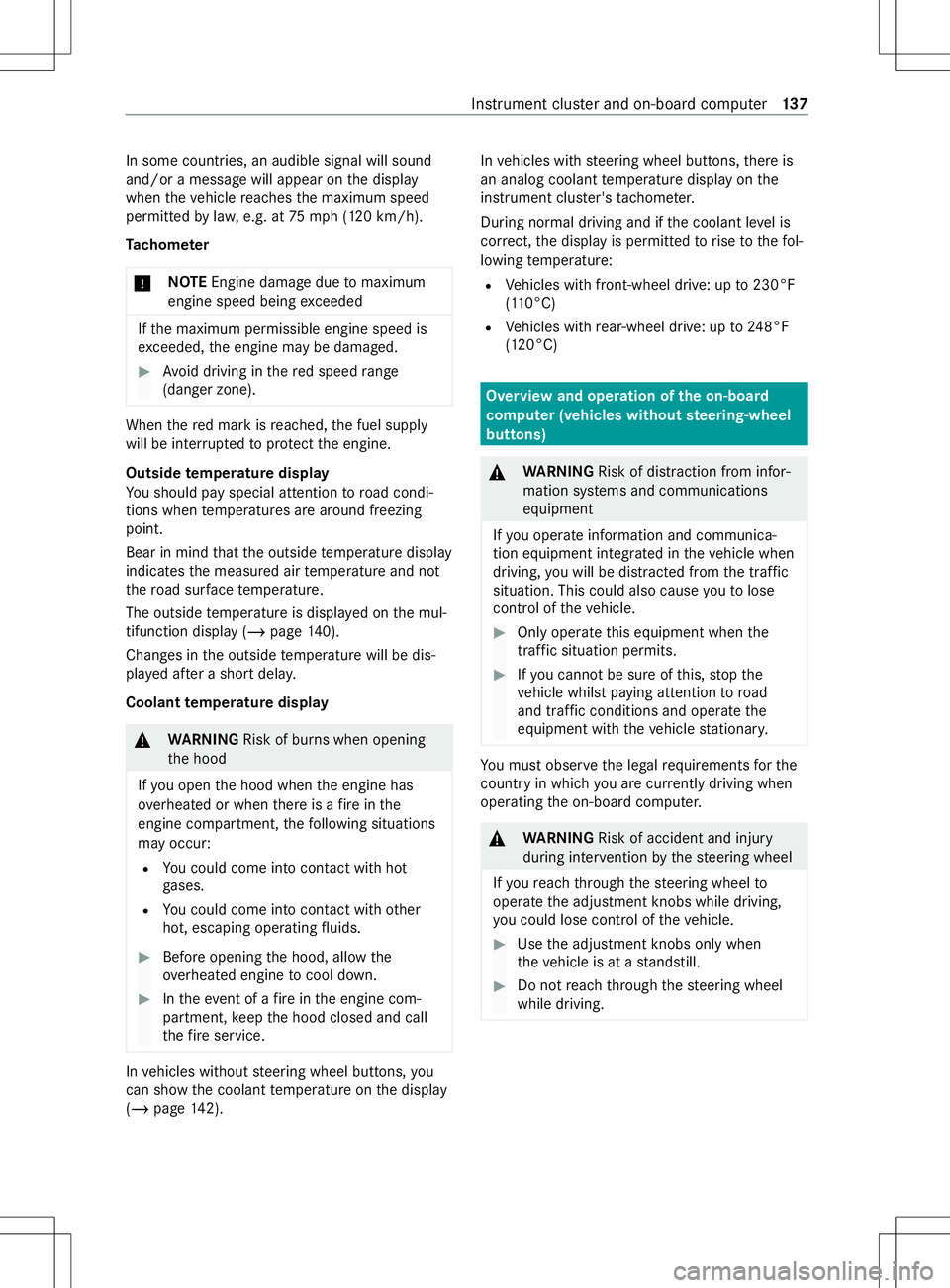
In some countries, an audible signal wills
ound
and/or amessag ewilla ppear on thed isplay
when thev ehicle reaches them aximum speed
permitted bylaw, e.g. at 75mph(120k m/h).
Ta ch ome ter
* NO
TEEngine damag eduetomaximum
engine speed being exceeded If
th em aximum permissible engine speed is
exc eeded, thee ngine ma ybedamaged. #
Avoid driving in ther ed speed range
(danger zone). Whe
nthe redm arkisr eached, thef uel supply
will be inter rupte dtop rotect thee ngine.
Outsid etem peratu re display
Yo us houl dpayspecial attention toroad condi‐
tions when temp eratures ar earound freezing
point.
Bear in mind that theo utside temp eratur edisplay
indicates them easured air temp eratur eand not
th er oad sur face temp erature.
The outside temp eratur eisdisplayedont he mul‐
tifunction displa y(/pag e140).
Changes in theo utside temp eratur ewill be dis‐
pla yeda fter as hor tdela y.
Coolant temperatur edisplay &
WARNING Risk of bu rnsw hen opening
th eh ood
If yo uo pen theh ood when thee ngine has
ov erheated or when ther eisaf ireint he
engine compartment, thef ollowing situations
ma yoccur:
R Youc oul dc om eintoc ontact wi thhot
ga ses.
R Youc oul dc om eintoc ontact wi thother
hot, escaping operating fluids. #
Befor eopening theh ood, allo wthe
ove rheated engine tocool down. #
Inthee vent of afireint he engine com‐
partment, keep theh ood closed and call
th ef ires ervice. In
vehicles without steering wheel buttons, you
can sho wthe coolant temp eratur eonthe display
(/ page142). In
vehicles wit hsteering wheel buttons, ther eis
an analog coolant temp eratur edispla yont he
instrument clus ter's tach ome ter.
During norma ldriving and if thec oolant le velis
cor rect, thed ispla yisp ermitted torise tothef ol‐
lowing temp erature:
R Vehicles wit hfront-wheel drive: up to230°F
(1 10 °C)
R Vehicles wit hrear-wheel drive: up to248°F
(120°C) Overvie
wand operation of theo n-boa rd
compu ter( ve hicles without steering-wheel
but tons) &
WARNING Risk of distraction from infor‐
mation sy stems and communications
equipment
If yo uo perat einformation and communica‐
tio ne quipment integrated in thev ehicle when
driving, youw ill be distracted from thet raffic
situation. This could also cause youtol ose
control of thev ehicle. #
Onlyoperat ethis equipment when the
traf fics ituation permits. #
Ifyo uc anno tbes ureoft his,stop the
ve hicle whils tpaying attention toroad
and traf ficc onditions and ope rate the
equipment wit hthe vehicle stationar y. Yo
um usto bse rvet he legal requirements fort he
countr yinwhich youa recur rentl yd riving when
ope rating theo n-boar dcomputer. &
WARNING Risk of accident and injury
du ring inter vention bythes teering wheel
If yo ur eac hthrough thes teering wheel to
operat ethe adjustment knobs while driving,
yo uc oul dlose control of thev ehicle. #
Use thea djustmen tknobs onl ywhen
th ev ehicle is at astandstill. #
Do no treac hthrough thes teering wheel
while driving. Instrument clus
tera nd on-boar dcomputer 137